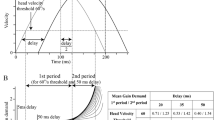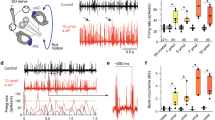Summary
The vestibulo-ocular reflex (VOR) operates to stabilize the eyes in space during movements of the head. The system has been described as having a gain of approximately -1 since stimulation of the semi-circular canals brought about by head movements will have the effect of causing the eyes to rotate an equal amount in the opposite direction. Change in the gain of the VOR has been put forth as a model to study plasticity in the central nervous system. Since numerous studies have implicated norepinephrine (NE) in neuroplasticity and modifiability of neural circuits, we attempted to determine the effect of NE depletion (via 6-hydroxydopamine (6-OHDA) intra-cisternal injection) on the modifiability of the VOR. We have found that cats increase the gain of their VOR over a four hour period when rotated in the horizontal plane in a manner equal but opposite to the rotation of a surrounding opto-kinetic drum. The entire group of animals manifests a statistically significant decrement in their ability to increase VOR gain when central stores of norepinephrine are depleted via intra-cisternal injection of 6-OHDA. Individual animals manifest a wide variety of gain changes (0.98 to 1.62). We have found that there were two groups of cats — high and low gain modifiers. The greatest reduction in VOR gain increase after NE depletion was observed in the high gain modifiers. No difference was observed in the low gain modifiers. These same animals tested for VOR modification after amphetamine injection, produced similar results. Alertness during the VOR modification task, as estimated by saccadic eye movement counts, was unchanged after NE depletion. NE levels, measured by HPLC-EC, after depletion were reduced to the greatest extent in the cerebellum. There was also a substantial reduction of NE in the visual cortex with less of a reduction in the brain stem.
Similar content being viewed by others
References
Albus JS (1971) A theory of cerebellar function. Math Biosci 10: 25–61
Barlow D, Freedman W (1980) Cervico-ocular reflex in the normal adult. Acta Otolaryngol 89: 487–496
Barlow D, Freedman W (1981) Human cervico-ocular reflex in the presence of a visual stimulus. IEEE Trans Biomed Eng BME 28(4): 364–366
Boyeson MG, Krobert KA, Hughes JM (1986) Norepinephrine infusions into the cerebellum facilitate recovery from sensori motor cortex injury in the rat. Soc Neurosci Abstr 12: 304, 13 1120
Breese GR, Traylor TD (1971) Depletion of brain noradrenaline and dopamine by 6-hydroxydopamine. Br J Pharmacol 42: 88–99
Collins WE, Guedry FE (1962) Arousal effects and nystagmus during prolonged constant angular acceleration. Acta Otolaryngol (Stockholm) 54: 349
Demer JL (1981) The variable gain element of the vestibulo-ocular reflex is common to the optokinetic system of the cat. Brain Res 14: 220(1): 1–13
Demer JL, Robinson DA (1982) Effects of reversible lesions and stimulation of olivocerebellar system on vestibulo-ocular reflex plasticity. J Neurophysiol 47: 1084–1107
Ebner JT, Bloedel JR (1981) Role of climbing fiber afferent input in determining responsiveness of Purkinje cells to mossy fiber inputs. J Neurophysiol 45: 962–971
Ebner T, Qi-Xiang Y, Bloedel JR (1983) Increase in Purkinje cell gain associated with naturally activated climbing fiber input. J Neurophysiol 50: 205–219
Gonshor A, Melvill Jones G (1976) Extreme vestibulo-ocular adaptation induced by prolonged optical reversal of vision. J Physiol (Lond) 256: 381–384
Gilbert PFC (1975) How the cerebellum could memorize movements. Nature (Lond) 254: 688–689
Hoffer BJ, Siggins GR, Oliver AP, Bloom FE (1973) Activation of the pathway from locus coeruleus to rat cerebellar Purkinje neurons: pharmacological evidence for central adrenergic inhibition. J Pharmacol Exp Ther 184: 553–569
Ito M (1984) The cerebellum and neural control. Raven Press, New York
Ito M, Sakaurai M, Tongroach P (1982) Climbing fiber induced depression of both mossy fiber responsiveness and glutamate sensitivity of cerebellar Purkinje cells. J Physiol 324: 113–134
Ito M, Shiida T, Yagi N, Yamamoto M (1974) The cerebellar modification of rabbits' horizontal vestibulo-ocular reflexes induced by sustained head rotation combined with visual stimulation. Proc Jpn Acad 50: 85–89
Jonsson G, Malmfors T, Sachs C (1972) Effects of drugs on the 6hydroxydopamine induced degeneration of adrenergic nerves. Res Commun. Chem Path Pharmacol 3: 543–556
Judge SJ, Richmond BJ, Chu FC (1980) Implantation of magnetic search coils for measurement of eye position: an improved method. Vision Res 20: 535–553
Kasamatsu T, Pettigrew JD, Ary M (1979) Restoration of visual cortical plasticity by local microperfusion of norepinephrine. J Comp Neurol 185: 163–182
Keller EL, Smith MJ (1983) Suppressed visual adaptation of the vestibulo-ocular reflex in catecholamine-depleted cats. Brain Res 258: 323–327
Kissinger PT, Refshauge CJ, Dreiling R, Adams RN (1973) An electrochemical detector for liquid chromatography with picogram sensitivity. Anal Lett 6: 465–477
Kobayashi RM, Palkovits M, Kopin IJ, Jacobowitz DM (1974) Biochemical mapping of the noradrenergic nerves arising from the rat locus coeruleus. Brain Res 77: 269–279
Lisberger S, Miles F, Optican L (1983) Frequency-selective adaptation: evidence for channels in the vestibulo-ocular reflex. J Neurosci 3: 1234–1244
Lisberger S, Miles FA, Zee DS (1984) Signals used to compute errors in monkey vestibulo-ocular reflex: possible role of flocculus. J Neurophysiol 52(6): 1140–53
Llinás R, Walton K (1979) Place of the cerebellum in motor learning. In: Brazier MD (ed) Brain mechanisms in memory and learning. Raven Press, New York
Maioli C, Precht W (1984) The horizontal optokinetic nystagmus in the cat. Exp Brain Res 55(3): 494–506
Marr D (1969) A theory of cerebellar cortex. J Physiol 202: 437–470
McElligott JG, Ebner TJ, Bloedel JR (1986) Reduction of cerebellar norepinephrine alters climbing fiber enhancement of mossy fiber input to the Purkinje cell. Brain Res 397: 245–252
McElligott JG, Keller EL (1981) Neuronal discharge in the posterior cerebellum: its relation to saccadic eye movement generation. In: Lennerstrand G et al. (eds) Functional basis of ocular motility disorders. Pergamon Press, Oxford
McElligott JG, Loughnane M, Mays L (1979) The use of synchronous demodulation for the measurement of eye movements by means of an ocular magnetic search coil. IEEE Biomed Eng 26: 370–374
McElligott JG, Waterhouse BD (1977) A technique for repeatable implantation of microelectrodes into the brain of an awake and unrestrained cat. Physiol Behav 18: 163–167
Miles FA, Fuller JH (1974) Adaptive plasticity of the vestibulo-ocular response of the rhesus monkey. Brain Res 80: 512–516
Miles FA, Lisberger SG (1981) Plasticity in the vestibulo-ocular reflex: a new hypothesis. Ann Rev Neurosci 4: 273–299
Miyashita Y, Watanabe E (1984) Loss of vision-guided adaptation of the vestibulo-ocular reflex after depletion of brain serotonin in the rabbit. Neurosci Lett 51: 177–182
Moises HC, Woodward DJ (1980) Potentiation of GABA inhibitory action in cerebellum by locus coeruleus stimulation. Brain Res 182: 327–344
Moises HC, Woodward DJ, Hoffer BJ, Freedman R (1979) Interactions of norepinephrine with Purkinje cell responses to putative amino acid neurotransmitters applied by microiontophoresis. Exp Neurol 64: 493–515
Moore RY, Bloom FE (1979) Central catecholamine neuron systems: anatomy and physiology of norepinephrine and epinephrine systems. Ann Rev Neurosci 2: 113–168
Robinson DA (1963) A method of measuring eye movement using a scleral search coil in a magnetic field. IEEE Trans Biomed Eng BME-10: 137–145
Robinson DA (1976) Adaptive gain control of the vestibuloocular reflex to the cerebellum. J Neurophysiol 39: 954–969
Strahlendorf JC, Hubbard GD (1983) Serotonergic interactions with rat cerebellar Purkinje cells. Brain Res Bull 11: 265–269
Watson M, McElligott JG (1983) Six-hydroxydopamine induced effects upon the acquisition of locomotor tasks in rats. Pharmacol Biochem Behav 18: 927–934
Watson M, McElligott JG (1984) Cerebellar norepinephrine depletion and impaired acquisition of specific locomotor tasks in rats. Brain Res 296: 129–138
Woodward DJ, Moises HC, Waterhouse BD, Hoffer BJ, Freedman R (1979) Modulatory actions of norepinephrine in the central nervous system. Fed Proc 38: 2109–2116
Author information
Authors and Affiliations
Rights and permissions
About this article
Cite this article
McElligott, J.G., Freedman, W. Vestibulo-ocular reflex adaptation in cats before and after depletion of norepinephrine. Exp Brain Res 69, 509–521 (1988). https://doi.org/10.1007/BF00247305
Received:
Accepted:
Issue Date:
DOI: https://doi.org/10.1007/BF00247305




